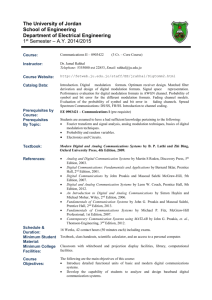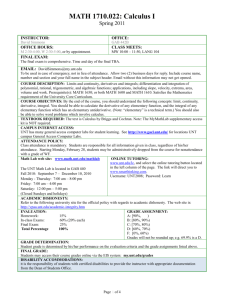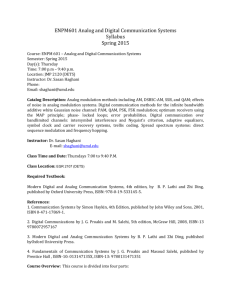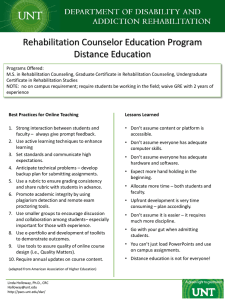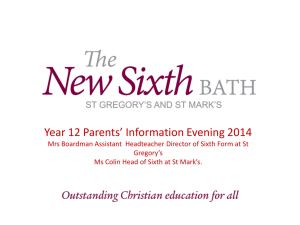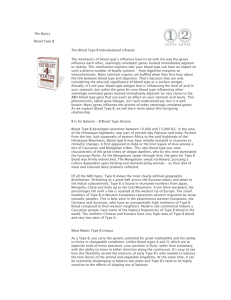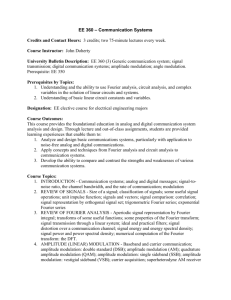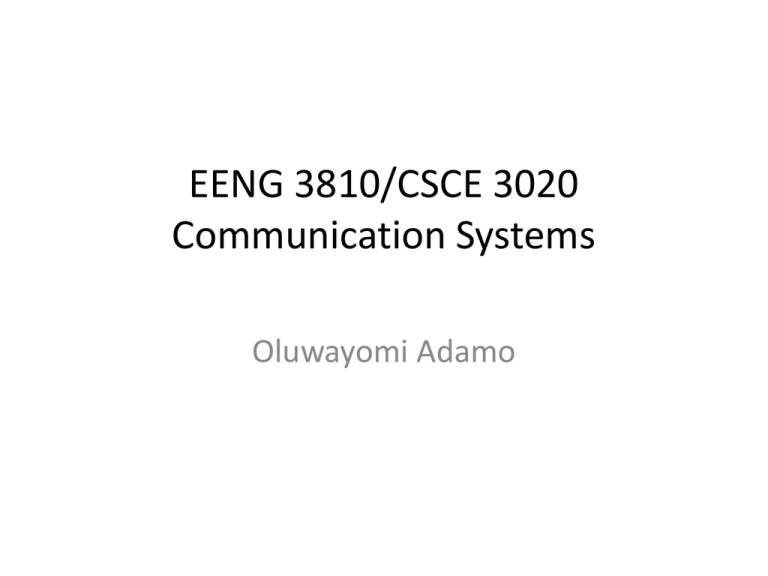
EENG 3810/CSCE 3020
Communication Systems
Oluwayomi Adamo
Outline
• Instructor Information
• Course Motivation
• Course Information
–
–
–
–
–
–
Description
Objectives
Required and Reference Textbooks
Homework, Projects and Exams
Grade and Attendance policies
Tentative Schedule
• Chapter 1
Instructor Information
Name: Oluwayomi Adamo
Email: oluwayomi.adamo@unt.edu
Phone: 940-891-6874
Office : B208
Office Hours: Tues & Thurs 4 – 5 PM
Course Website:
www.ee.unt.edu/public/adamo/EENG3810_F09
TA: TBD
Course Motivations
• Rapid Expansion of digital communication
technologies – Internet
• Influence of communication technologies such
as cell phones, bluetooth etc
• Improvement of productivity and energy
conservation e.g teleconferencing saves time
and energy – travel not required
• Promotes globalization
• There is need to design better communication
systems for the future
Course Description
• What is a communication system?
• What are the major types?
• Analog or Digital
• Satellite, Fiber, Wireless…
• What are the theorems?
• What are the major components?
• How is the information transmitted?
Textbooks
• Required
B.P. Lathi, Modern Digital and Analog Communication
Systems, 4th edition, Oxford University Press, 1998
ISBN: 9780195331455
• Reference
Leon W. Couch, II, Digital and Analog Communication
Systems, 7th edition, Pearson, Prentice Hall, 2007
ISBN: 0131424920
R. E. Ziemer and W. H. Tranter, Principles of
Communications, Systems, Modulation and Noise 6th
Edition, Wiley, 2009 ISBN: 9780470252543
Assignments, Project and Exam (Tentative)
• Assignments
– Every week except if labs are due
• Project
– 2 labs and 1 project
• Exams
– Quizzes every week
– 3 exams
• Test 1 : Sept. 30, 2009
• Test 2 : Nov. 2, 2009
• Test 3 : Dec. 14, 2009
Course Grading
• 3 Tests – 60%
– (Test 1 – Sept. 30, Test 2 – Nov. 2, Test 3 – Dec. 14)
•
•
•
•
•
Assignments – 20%
Labs – 5%
Quizzes – 5%
Project – 10%
Attendance is Mandatory
Course Policies
• Class attendance is mandatory. You will need to sign
attendance sheet every class
• It is strongly encouraged to get to know each other in
the class. Discussions on course materials are
allowed!
• Everyone must turn in her/his own individual work.
Simply copying other’s homework will be treated as a
violation of academic honesty
Course Policies (CNTD)
• It is the responsibility of students with
certified disabilities to provide the instructor
with appropriate documentation from the
Dean of Students Office (see
http://www.unt.edu/oda)
• Please visit http://www.unt.edu/csrr/ for your
rights and responsibilities
Teaching Styles
• Slides and White board
Slides can convey more information in an
organized way
Blackboard is better for equations and prevents
you from not coming.
• Course Website
Print handouts with 3 slides per page before you
come
Homework assignment and solutions
Project descriptions and preliminary codes
Tentative Topics
•
•
•
•
•
•
•
•
Introduction to communication Systems
Review of Signals
Amplitude modulation and Demodulation
Angle modulation/frequency modulation
Sampling and pulse code modulation
Principles of digital data transmission
Overview of probability
Performance Analysis of Modulated and digital
Communications Systems
• Spread Spectrum Communications
Questions



